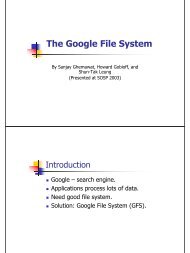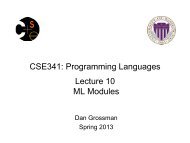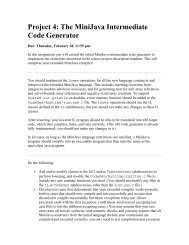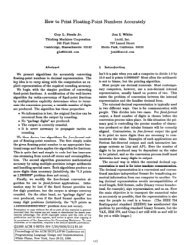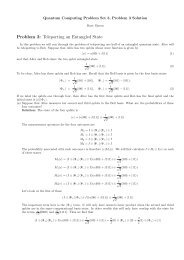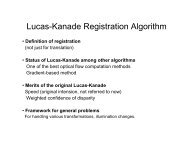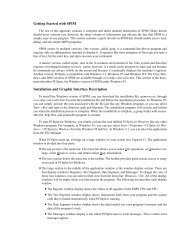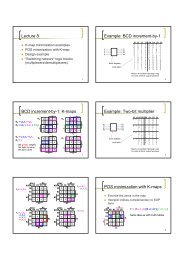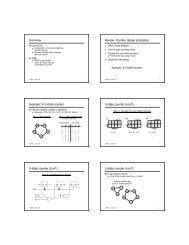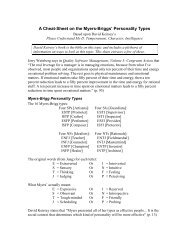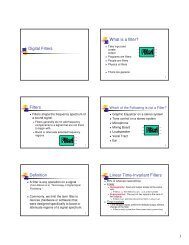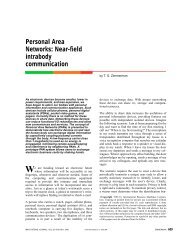Computational Geometry Convex Hull Line Segment Intersection ...
Computational Geometry Convex Hull Line Segment Intersection ...
Computational Geometry Convex Hull Line Segment Intersection ...
Create successful ePaper yourself
Turn your PDF publications into a flip-book with our unique Google optimized e-Paper software.
Autumn 2001<br />
<strong>Computational</strong> <strong>Geometry</strong><br />
<strong>Convex</strong> <strong>Hull</strong><br />
<strong>Line</strong> <strong>Segment</strong> <strong>Intersection</strong><br />
Voronoi Diagram
• Algorithms about points, lines, planes,<br />
polygons, triangles, rectangles and other<br />
geometric objects.<br />
• Applications in many fields<br />
– robotics, graphics, CAD/CAM, geographic<br />
systems,<br />
• We have done some already<br />
– Euclidian traveling salesman<br />
– Nearest neighbors<br />
CSE 589 - Lecture 10 - Autumn<br />
2001<br />
2
• Given n points on the plane find the smallest<br />
enclosing curve.<br />
CSE 589 - Lecture 10 - Autumn<br />
2001<br />
3
• The convex hull is a polygon whose vertices<br />
are some of the points.<br />
CSE 589 - Lecture 10 - Autumn<br />
2001<br />
4
• Input:<br />
Set of points p 1, p 2, ... , p n in 2 space. (Each<br />
point is an ordered pair p = (x,y) of reals.)<br />
• Output:<br />
A sequence of points p i1, p i2, ... , p ik such that<br />
traversing these points in order gives the<br />
convex hull.<br />
CSE 589 - Lecture 10 - Autumn<br />
2001<br />
5
p 1<br />
p6<br />
p 4<br />
p 5<br />
p 3<br />
p 7<br />
p 10<br />
p 2<br />
p 8<br />
p 11<br />
CSE 589 - Lecture 10 - Autumn<br />
2001<br />
p 12<br />
Input: p 1 , p 2 , p 3 , p 4 , p 5 , p 6 , p 7 , p 8 , p 8 , p 9 , p 10 , p 11 , p 12<br />
Output: p 6 , p 1 , p 2 , p 11 , p 12 , p 10<br />
p 9<br />
6
• For each pair of points p, q determine if the<br />
line from p to q is on the convex hull.<br />
No<br />
CSE 589 - Lecture 10 - Autumn<br />
2001<br />
Yes<br />
7
• For each pair of points p, q, form the line that<br />
passes through p and q and determine if all<br />
the other points are on one side of the line.<br />
– If so the line from p to q is on the convex hull<br />
– Otherwise not<br />
• Time Complexity is O(n 3 )<br />
– Constant time to test if point is on one side of the<br />
line<br />
0 =<br />
(q − p )x + (p − q )y + p q − p<br />
2<br />
2<br />
1<br />
CSE 589 - Lecture 10 - Autumn<br />
2001<br />
1<br />
2<br />
1<br />
1<br />
q<br />
2<br />
8
• Sort the points from left to right (sort on the<br />
first coordinate in increasing order)<br />
CSE 589 - Lecture 10 - Autumn<br />
2001<br />
9
• Process the points in left to right order<br />
CSE 589 - Lecture 10 - Autumn<br />
2001<br />
10
• Right Turn<br />
CSE 589 - Lecture 10 - Autumn<br />
2001<br />
11
• Right Turn<br />
CSE 589 - Lecture 10 - Autumn<br />
2001<br />
12
• Left Turn – back up<br />
CSE 589 - Lecture 10 - Autumn<br />
2001<br />
13
• Left Turn – back up<br />
CSE 589 - Lecture 10 - Autumn<br />
2001<br />
14
CSE 589 - Lecture 10 - Autumn<br />
2001<br />
15
• Left Turn – back up<br />
CSE 589 - Lecture 10 - Autumn<br />
2001<br />
16
CSE 589 - Lecture 10 - Autumn<br />
2001<br />
17
• Right Turn<br />
CSE 589 - Lecture 10 - Autumn<br />
2001<br />
18
• Left Turn – back up<br />
CSE 589 - Lecture 10 - Autumn<br />
2001<br />
19
CSE 589 - Lecture 10 - Autumn<br />
2001<br />
20
• Left Turn – back up<br />
CSE 589 - Lecture 10 - Autumn<br />
2001<br />
21
CSE 589 - Lecture 10 - Autumn<br />
2001<br />
22
• Left Turn – back up<br />
CSE 589 - Lecture 10 - Autumn<br />
2001<br />
23
CSE 589 - Lecture 10 - Autumn<br />
2001<br />
24
• Left Turn – back up<br />
CSE 589 - Lecture 10 - Autumn<br />
2001<br />
25
CSE 589 - Lecture 10 - Autumn<br />
2001<br />
26
• Upper convex hull is complete<br />
Continue the process in reverse order to get the lower convex hull<br />
CSE 589 - Lecture 10 - Autumn<br />
2001<br />
27
• Right Turn<br />
CSE 589 - Lecture 10 - Autumn<br />
2001<br />
28
• Left Turn – back up<br />
CSE 589 - Lecture 10 - Autumn<br />
2001<br />
29
CSE 589 - Lecture 10 - Autumn<br />
2001<br />
30
• Right Turn<br />
CSE 589 - Lecture 10 - Autumn<br />
2001<br />
31
• Left Turn – back up<br />
CSE 589 - Lecture 10 - Autumn<br />
2001<br />
32
• Left Turn – back up<br />
CSE 589 - Lecture 10 - Autumn<br />
2001<br />
33
CSE 589 - Lecture 10 - Autumn<br />
2001<br />
34
• Right Turn<br />
CSE 589 - Lecture 10 - Autumn<br />
2001<br />
35
• Left Turn – back up<br />
CSE 589 - Lecture 10 - Autumn<br />
2001<br />
36
CSE 589 - Lecture 10 - Autumn<br />
2001<br />
37
• Right Turn<br />
CSE 589 - Lecture 10 - Autumn<br />
2001<br />
38
• Left Turn – back up<br />
CSE 589 - Lecture 10 - Autumn<br />
2001<br />
39
• Left Turn – back up<br />
CSE 589 - Lecture 10 - Autumn<br />
2001<br />
40
• Done!<br />
CSE 589 - Lecture 10 - Autumn<br />
2001<br />
41
• Not a left turn<br />
– Middle point is included in the convex hull<br />
CSE 589 - Lecture 10 - Autumn<br />
2001<br />
42
• Sort<br />
– First increasing in x<br />
– Second decreasing in y<br />
CSE 589 - Lecture 10 - Autumn<br />
2001<br />
43
• Slope increases from one segment to next<br />
(p 1 ,p 2 )<br />
left turn<br />
(q 1 ,q 2 )<br />
q<br />
q<br />
2<br />
1<br />
− p<br />
− p<br />
(r 1 ,r 2 )<br />
CSE 589 - Lecture 10 - Autumn<br />
2001<br />
2<br />
1<br />
r2<br />
<<br />
r<br />
1<br />
− q<br />
− q<br />
(q − p r − q ) < ( r − q )( q − p ) to avoid dividing by zero<br />
2<br />
2)(<br />
1 1 2 2 1 1<br />
2<br />
1<br />
44
• Sorting – O(n log n)<br />
• During the scan each point is “visited” at most<br />
twice<br />
– Initial visit<br />
– back up visit (happens at most once)<br />
• Scan - O(n)<br />
• Total time O(n log n)<br />
• This is best possible because sorting is<br />
reducible to finding convex hull.<br />
CSE 589 - Lecture 10 - Autumn<br />
2001<br />
45
• O(n log n)<br />
– Graham (1972)<br />
• O(n log h) algorithm where h is size of hull<br />
– Kirkpatrick and Seidel (1986)<br />
– Output sensitive algorithm<br />
• d-dimensional <strong>Convex</strong> <strong>Hull</strong><br />
– Ω(n d/2 ) in the worst case because the output can<br />
be this large.<br />
CSE 589 - Lecture 10 - Autumn<br />
2001<br />
46
• Given two convex hulls compute the<br />
combined convex hull in linear time.<br />
CSE 589 - Lecture 10 - Autumn<br />
2001<br />
47
Input output<br />
CSE 589 - Lecture 10 - Autumn<br />
2001<br />
48
CSE 589 - Lecture 10 - Autumn<br />
2001<br />
report the point and all the lines<br />
that meet there.<br />
Report the segment and all the<br />
lines that meet on it.<br />
49
• Polygons have no self intersections<br />
Use line segment intersection to solve polygon intersection<br />
CSE 589 - Lecture 10 - Autumn<br />
2001<br />
50
• What if no line segment intersections?<br />
CSE 589 - Lecture 10 - Autumn<br />
2001<br />
51
• Intersect a ray from each polygon with the other<br />
– Inside, if ray has an odd number of intersections, otherwise<br />
outside. Jordan curve theorem (1887).<br />
CSE 589 - Lecture 10 - Autumn<br />
2001<br />
52
• With n line segments there may be O(n 2 )<br />
intersections.<br />
• Goal: Good output sensitive algorithm<br />
– O(n log n + s) would be ideal where s is the<br />
number of intersections.<br />
CSE 589 - Lecture 10 - Autumn<br />
2001<br />
53
• Sweep a plane vertically from top to bottom<br />
maintaining the set of known future events.<br />
• Events<br />
– Beginning of a segment<br />
– End of a segment<br />
– <strong>Intersection</strong> to two “adjacent” segments<br />
CSE 589 - Lecture 10 - Autumn<br />
2001<br />
sweep<br />
direction<br />
54
• We maintain ordered list of segments<br />
d<br />
c<br />
f<br />
b<br />
segment ordering at y = c, d, f, b, e, a<br />
e<br />
CSE 589 - Lecture 10 - Autumn<br />
2001<br />
a<br />
y<br />
55
• Just before an intersection event the two line<br />
segments must be adjacent in the segment<br />
order.<br />
• When a new adjacency occurs between two<br />
lines we must check for a possible new<br />
intersection event.<br />
CSE 589 - Lecture 10 - Autumn<br />
2001<br />
56
• Event Queue<br />
– contains all the beginning points and all the end<br />
points of segments ordered by decreasing y value.<br />
c<br />
• <strong>Segment</strong> List<br />
– Empty<br />
b<br />
d<br />
e<br />
a<br />
CSE 589 - Lecture 10 - Autumn<br />
2001<br />
Event Queue<br />
b a ,b b ,b c ,b d ,e d ,b e ,e b ,e e ,e a ,e c<br />
57
• Remove the next event from the event queue<br />
begin segment event<br />
a<br />
b<br />
c<br />
end segment event<br />
a b<br />
CSE 589 - Lecture 10 - Autumn<br />
2001<br />
1. Insert b into the segment list<br />
between a and c<br />
2. Check for intersections with<br />
adjacent segments (a,b) and<br />
(b,c), and add any to event<br />
queue<br />
c 1. Delete b from the segment list<br />
2. Check for intersections with<br />
adjacent segments (a,c), and<br />
add any to event queue<br />
58
intersection event event<br />
a<br />
b<br />
c 1. Reverse the order of b and c<br />
d<br />
on the segment list<br />
2. Check for intersections with<br />
adjacent segments (a,c) and (b,d)<br />
and add any to event queue<br />
CSE 589 - Lecture 10 - Autumn<br />
2001<br />
59
• Several events can coincide.<br />
• Horizontal lines<br />
begin end<br />
CSE 589 - Lecture 10 - Autumn<br />
2001<br />
begin segment event<br />
end segment event<br />
intersection event<br />
do in left to right order<br />
60
c<br />
<strong>Segment</strong> List<br />
Event Queue<br />
b a , b b , b c , b d , e d , b e , e b , e e , e a , e c<br />
b<br />
d<br />
e<br />
a<br />
CSE 589 - Lecture 10 - Autumn<br />
2001<br />
61
c<br />
<strong>Segment</strong> List<br />
a<br />
Event Queue<br />
b b , b c , b d , e d , b e , e b , e e , e a , e c<br />
b<br />
d<br />
e<br />
a<br />
CSE 589 - Lecture 10 - Autumn<br />
2001<br />
62
c<br />
<strong>Segment</strong> List<br />
b, a<br />
Event Queue<br />
b c , b d , e d , b e , e b , e e , e a , e c<br />
b<br />
d<br />
e<br />
a<br />
CSE 589 - Lecture 10 - Autumn<br />
2001<br />
63
c<br />
<strong>Segment</strong> List<br />
c, b, a<br />
Event Queue<br />
b d , i (c,b) , e d , b e , e b , e e , e a , e c<br />
b<br />
d<br />
e<br />
a<br />
CSE 589 - Lecture 10 - Autumn<br />
2001<br />
64
c<br />
<strong>Segment</strong> List<br />
c, d, b, a<br />
Event Queue<br />
i (d,b) , i (c,b) , e d , b e , e b , e e , e a , e c<br />
b<br />
d<br />
e<br />
a<br />
CSE 589 - Lecture 10 - Autumn<br />
2001<br />
65
c<br />
<strong>Segment</strong> List<br />
c, b, d, a<br />
b<br />
Event Queue<br />
i (c,b) , e d , b e , e b , e e , e a , e c<br />
d<br />
e<br />
a<br />
CSE 589 - Lecture 10 - Autumn<br />
2001<br />
66
c<br />
<strong>Segment</strong> List<br />
b, c, d, a<br />
Event Queue<br />
e d , b e , e b , e e , e a , e c<br />
b<br />
d<br />
e<br />
a<br />
CSE 589 - Lecture 10 - Autumn<br />
2001<br />
67
c<br />
<strong>Segment</strong> List<br />
b, c, a<br />
Event Queue<br />
b e , e b , e e , e a , e c<br />
b<br />
d<br />
e<br />
a<br />
CSE 589 - Lecture 10 - Autumn<br />
2001<br />
68
c<br />
<strong>Segment</strong> List<br />
b, e, c, a<br />
Event Queue<br />
i (e,c) , e b , e e , e a , e c<br />
b<br />
d<br />
e<br />
a<br />
CSE 589 - Lecture 10 - Autumn<br />
2001<br />
69
c<br />
<strong>Segment</strong> List<br />
b, c, e, a<br />
Event Queue<br />
e b , i (e,a) e e , e a , e c<br />
b<br />
d<br />
e<br />
a<br />
CSE 589 - Lecture 10 - Autumn<br />
2001<br />
70
c<br />
<strong>Segment</strong> List<br />
c, e, a<br />
Event Queue<br />
i (e,a) , e e , e a , e c<br />
b<br />
d<br />
e<br />
a<br />
CSE 589 - Lecture 10 - Autumn<br />
2001<br />
71
c<br />
<strong>Segment</strong> List<br />
c, a, e<br />
Event Queue<br />
e e , e a , e c<br />
b<br />
d<br />
e<br />
a<br />
CSE 589 - Lecture 10 - Autumn<br />
2001<br />
72
c<br />
<strong>Segment</strong> List<br />
c, a<br />
Event Queue<br />
e a , e c<br />
b<br />
d<br />
e<br />
a<br />
CSE 589 - Lecture 10 - Autumn<br />
2001<br />
73
c<br />
<strong>Segment</strong> List<br />
c<br />
Event Queue<br />
e c<br />
b<br />
d<br />
e<br />
a<br />
CSE 589 - Lecture 10 - Autumn<br />
2001<br />
74
c<br />
<strong>Segment</strong> List<br />
Event Queue<br />
b<br />
d<br />
e<br />
a<br />
CSE 589 - Lecture 10 - Autumn<br />
2001<br />
75
• Event List<br />
– Priority queue ordered by decreasing y, then by<br />
increasing x<br />
– Delete minimum, Insertion<br />
• <strong>Segment</strong> List<br />
– Balanced binary tree search tree<br />
– Insertion, Deletion<br />
– Reversal can be done by deletions and insertions<br />
• Time per event is O(log n)<br />
CSE 589 - Lecture 10 - Autumn<br />
2001<br />
76
• Total time for plane sweep algorithm is<br />
O(n log n + s log n) where s is the number of<br />
intersections.<br />
– n log n for the initial sorting<br />
– log n per event<br />
• Plane sweep algorithms were pioneered by<br />
Shamos and Hoey (1975).<br />
• <strong>Intersection</strong> Reporting - Bentley and Ottmann<br />
(1979)<br />
CSE 589 - Lecture 10 - Autumn<br />
2001<br />
77
Vertex<br />
Edge<br />
Each site defines an area of points nearest to it.<br />
Boundaries are perpendicular bisectors.<br />
http://www.cs.cornell.edu/Info/People/chew/Delaunay.<br />
CSE 589 - Lecture 10 - Autumn<br />
2001<br />
Site<br />
78
• Each Voronoi area is the intersection of half<br />
spaces defined by perpendicular bisectors.<br />
CSE 589 - Lecture 10 - Autumn<br />
2001<br />
O(n 2 log n) time<br />
79
• The Voronoi Diagram is a planar embedding<br />
so it obeys Euler’s equation V −E<br />
+ F = 2<br />
CSE 589 - Lecture 10 - Autumn<br />
2001<br />
Vertices = 7 (single vertex at infinity)<br />
Edges = 11<br />
Faces = 6<br />
80
• F = E - V + 2 (Euler’s equation)<br />
• n = F (one site per face)<br />
• 2E > 3V because each vertex is of degree at<br />
least 3 and each edge has 2 vertices.<br />
• n > 3V/2 – V + 2 = V/2 + 2<br />
• 2n – 2 > V<br />
• n > E – (2n – 2) + 2<br />
• 3n – 4 > E<br />
CSE 589 - Lecture 10 - Autumn<br />
2001<br />
81
1. A vertex is the center of a circle through at<br />
least three sites<br />
CSE 589 - Lecture 10 - Autumn<br />
2001<br />
82
2. A point on a perpendicular bisector of sites p and q<br />
is on an edge if the circle centered at the point<br />
through p and q contains no other sites.<br />
CSE 589 - Lecture 10 - Autumn<br />
2001<br />
83
• We maintain a “beach line,” a sequence of<br />
parabolic segments that is the set of point<br />
equidistant from a site and the sweep line.<br />
• Events<br />
– Site event – new site is encountered by the sweep<br />
line<br />
– Circle event – new vertex is inserted into the<br />
Voronoi diagram<br />
CSE 589 - Lecture 10 - Autumn<br />
2001<br />
84
each line<br />
event queue<br />
a, b, c<br />
b<br />
a<br />
CSE 589 - Lecture 10 - Autumn<br />
2001<br />
c<br />
85
site point event<br />
beach line<br />
a<br />
event queue<br />
b, c<br />
b<br />
a<br />
CSE 589 - Lecture 10 - Autumn<br />
2001<br />
c<br />
86
points equidistant from point and line<br />
beach line<br />
a<br />
event queue<br />
b, c<br />
b<br />
a<br />
CSE 589 - Lecture 10 - Autumn<br />
2001<br />
c<br />
87
site event<br />
beach line<br />
a, b, a<br />
event queue<br />
c<br />
b<br />
a<br />
CSE 589 - Lecture 10 - Autumn<br />
2001<br />
c<br />
88
eakpoint<br />
segment<br />
beach line<br />
a, b, a<br />
event queue<br />
c<br />
b<br />
a<br />
CSE 589 - Lecture 10 - Autumn<br />
2001<br />
c<br />
89
each line<br />
a, b, a, c, a<br />
event queue<br />
?<br />
b<br />
a<br />
CSE 589 - Lecture 10 - Autumn<br />
2001<br />
c<br />
site event<br />
90
each line<br />
a, b, a, c, a<br />
event queue<br />
c (b,a,c)<br />
b<br />
a<br />
CSE 589 - Lecture 10 - Autumn<br />
2001<br />
c<br />
circle event must be<br />
added to the event queue<br />
91
each line<br />
a, b, a, c, a<br />
event queue<br />
c (b,a,c)<br />
b<br />
a<br />
CSE 589 - Lecture 10 - Autumn<br />
2001<br />
c<br />
92
each line<br />
a, b, c, a<br />
event queue<br />
b<br />
a<br />
CSE 589 - Lecture 10 - Autumn<br />
2001<br />
c<br />
circle event<br />
93
each line<br />
a, b, c, a<br />
event queue<br />
b<br />
a<br />
CSE 589 - Lecture 10 - Autumn<br />
2001<br />
c<br />
94
• Contains site events and circle events sorted<br />
by y in decreasing order, then by x in<br />
increasing order<br />
• Circle events can be both inserted and<br />
deleted.<br />
b<br />
CSE 589 - Lecture 10 - Autumn<br />
2001<br />
a<br />
c<br />
95
• Implemented as a balanced binary search tree.<br />
– sites at leaves<br />
– breakpoints at internal nodes<br />
b<br />
a<br />
c<br />
CSE 589 - Lecture 10 - Autumn<br />
2001<br />
a:b<br />
b:a<br />
c:a<br />
a:c<br />
a b a c<br />
a<br />
96
• For each site output the vertices in clockwise order.<br />
When a circle event occurs add to the vertex list of<br />
the three (or more) sites.<br />
inf<br />
inf<br />
f a<br />
2<br />
1<br />
e d<br />
c<br />
inf<br />
CSE 589 - Lecture 10 - Autumn<br />
2001<br />
b<br />
inf<br />
1. f, a, d, c, e<br />
2. f, a, b, inf<br />
97
• Number of segments in the beach line < 2n<br />
– Each site event adds at most 2 segments.<br />
• Number of circle event insertions < 2n<br />
– Each site event creates at most 2 circle events.<br />
• Time per event is O(log n)<br />
– Insert new segments into the segment tree.<br />
– Insert new circle events into the event queue<br />
– Delete circle events from the event queue<br />
• Total time is O(n log n)<br />
CSE 589 - Lecture 10 - Autumn<br />
2001<br />
98
• Voronoi diagram<br />
– Dirichlet (1850), Voronoi (1907)<br />
• O(n log n) algorithm<br />
– Divide and conquer - Shamos and Hoey (1975)<br />
– Plane sweep – Fortune (1987)<br />
CSE 589 - Lecture 10 - Autumn<br />
2001<br />
99
• Give an O(n log n) algorithms which given a<br />
set of n points on the plane, for each point<br />
finds its nearest neighbor.<br />
CSE 589 - Lecture 10 - Autumn<br />
2001<br />
100



